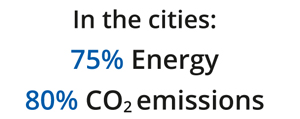The term Smart Cities means those cities that gradually increase self-sufficiency and environmental sustainability. Also, these towns have energy as a common factor, its production and use, its accumulation and smart management.
7.700 Smart Cities in Europe
At the moment, there are around 7,700 cities in Europe and more than 9,000 throughout the world candidate for being Smart Cities, with around 250 million inhabitants.
Cities are responsible for about 75% of total energy consumption and 80% of greenhouse gas emissions, hence the identification of the thematic areas on which to focus attention:
- production of photovoltaic energy;
- transport;
- storage.

1] Energy production
20% of the actions taken by Smart Cities consider solar photovoltaics as a viable solution for having cleaner and more sustainable cities, for the following reasons:
- The possibility of being distributed and decentralized, close to the points of consumption (reduction of the impact on the networks);
- The easy integration in every component of an urban area, preserving the architectural identity.
2] Transport development
The transport sector is responsible for a high amount of greenhouse gas emissions. 23% of smart actions will probably concern the development of transport. For this reason, it could become a cleaner and more sustainable sector, with vehicles that cover short distances (for example, public transport) as their main target.
3] Storage
The third field of intervention concerns storage: in the residential and commercial sector, the optimal management of consumption and withdrawals from the network, may lead to cost reduction and an increase in the use of renewable energy.
In addition to the increase in self-consumption, an accumulation system also allows the management of peak requests (meaning power), supporting the loads in the absence of the network and offering network services.
With photovoltaics 36% less CO2 emissions
Photovoltaics would allow a significant reduction in CO2 emissions which, as regards the EU building stock, is 36% compared to total emissions.






